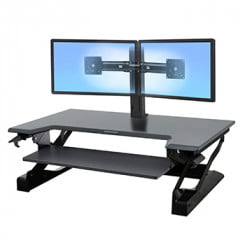Described by Men’s Health as “the most dangerous thing you’ll do all day”, sitting at a desk can be seriously damaging to your health.
With the benefits of standing desks now widely recognised, office workers are increasingly choosing to stand up during working hours in an attempt to improve their health.
Standing allows you to increase the amount of movement in your day, helps you stay energised during the afternoon slump and can help you improve your posture and steer clear of back pain. You are likely to slouch less, enabling you to breathe better, not to mention that standing at your desk will increase your metabolism and help you burn more calories. It’s also great for sharing information with colleagues, a group of you standing around a desk gives each of you much better visibility of your screen than if you were all sitting down.
There are dozens of online hacks showing you how to get creative and make your own standing desk, or even how to incorporate a treadmill or exercise bike into your workspace, all of which are a great short term solution if you are on a budget.
But standing at your desk all day when you’re unused to it can cause problems too. We’re only human, and there are times of the day when we naturally want to sit down to rest or concentrate. Standing for long periods of time can put a lot of pressure on the lower back, give you sore feet and exacerbate varicose veins. One office worker details how standing desks can be problematic in a shared office, causing colleagues to find alternatives to sitting and highlighting the hazards associated with finding yourself at the armpit level of a taller colleague. Apartment Therapy posted recently about the challenges of adapting to a standing desk and the importance of listening to your body to find a balance of standing and sitting that suits you.
-
 Ergotron WorkFit SR£864.00 (incl VAT)
Ergotron WorkFit SR£864.00 (incl VAT) -
 Ergotron WorkFit-TL£546.00 (incl VAT)
Ergotron WorkFit-TL£546.00 (incl VAT)
When you type, read and eat at your desk for hours on end, neither standing nor sitting all day is a healthy option. For the sake of your wellbeing, it’s really worth investing in a serious piece of kit and employers are increasingly choosing height adjustable desks as a way of improving the comfort of their staff. Choosing a bank of desks with adjustable legs is the most cost-effective way of doing this; individuals are rarely the same height, so an adjustable desk is flexible enough to be fine-tuned for each individual member of staff.
An electric height adjustable desk allows you to alternate between standing and sitting throughout the day and gives you the best of both worlds at the push of a button. Standing gives you all the benefits cited above, then an adaptable frame gives you the option of lowering your desk to an appropriate level when you are tired, your feet start to ache or you simply need a break from standing up.
-
 Desk raisers (Pack of 4)£24.00 (incl VAT)
Desk raisers (Pack of 4)£24.00 (incl VAT) -
 Gymba Board£142.80 (incl VAT)
Gymba Board£142.80 (incl VAT)
We’ve written before about how a height adjustable desk can improve your health and we’ve gathered a selection of infographics on our “Wellbeing at Work” pinboard about the benefits of standing at work. We are frequently asked for advice from our customers on how to best use a height adjustable desk so here is what we tell them:
- Alternate as appropriate between standing and sitting
- Don’t lock your knees when standing. Allowing them to be loose will encourage movement
- Wear comfortable shoes
- Get a rug or anti-fatigue mat to stand on to ease pressure on your legs and feet
- Take regular breaks to walk around
- Try not to put all the weight through one leg – a rocker board will prevent this
- Work to music if you can. This will encourage you to dance at your desk a bit. Extra movement is always good
- Don’t forget to stretch throughout the day








